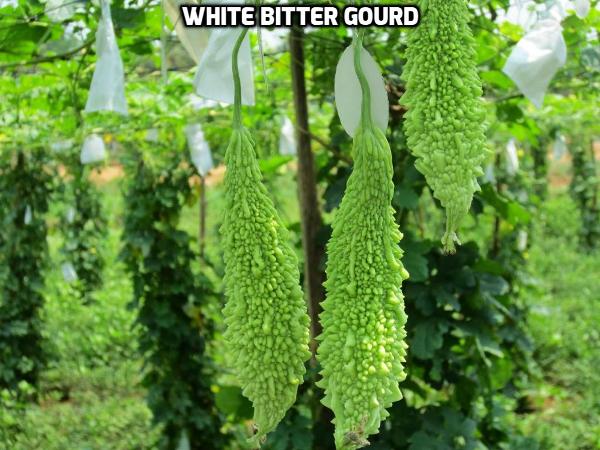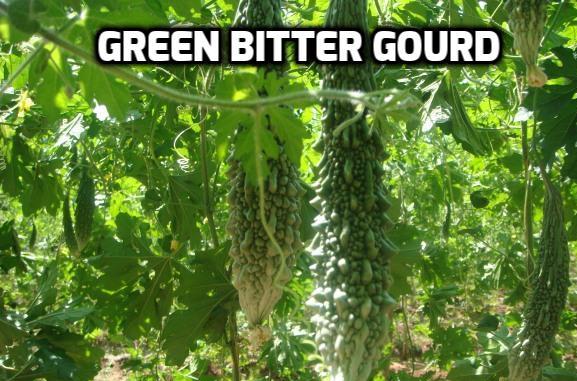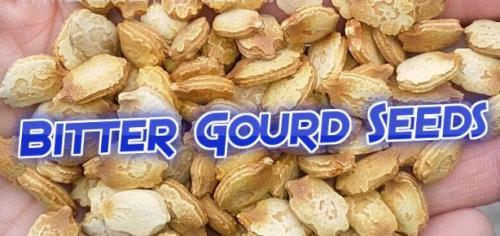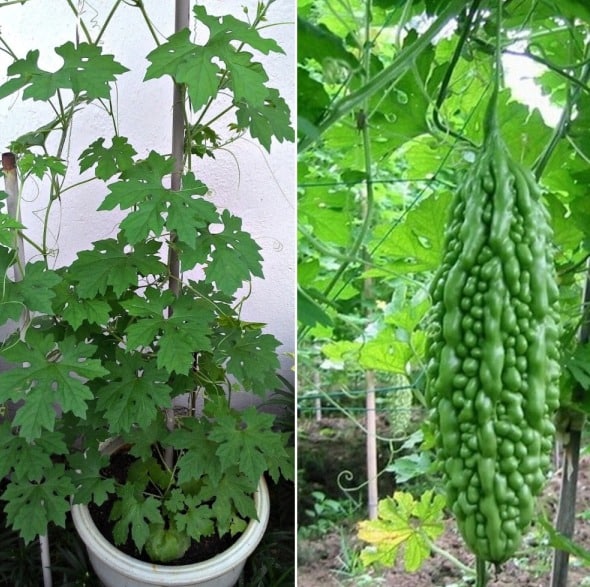Growing Bitter Gourd in Containers
The following topic is about Growing Bitter Gourd In Containers.
Introduction To Bitter Gourd (Karela)
Bitter Gourd is a tropical vine vegetable plant widely grown in Asia. Bitter guard is a quick crop, grown easily in the container with very less effort and produces good yields. The vines of the plants grow up to 6 to 7 feet and bear light green alternate leaves with three deeply separated lobes. This plant bears yellow colored male and female flowers, which are pollinated by insects. The bitter guard comes in many varieties and each one has different shapes and sizes. Bitter gourd is often eaten green before it begins to turn yellow. The bitter gourd is easily grown from seeds and produces fruits round the year. Bitter gourd is a vine plant, it needs some support to grow. Bitter gourd has very delicate flesh with large seeds. Bitter gourd is a warm season plant, thrives well in hot and humid climates. Bitter gourd needs fertile, well-drained soil with pH levels between 5.5 to 6.7. Bitter gourd thrives well in soil with rich organic matter. the Bitter gourd plant needs constant watering and produces fruit in 4 to 6 months after sowing seeds. Bitter guard plants are susceptible to diseases and pests, they need good care during the growing period and fruiting period.
- Scientific Name for Bitter Gourd: Momordica charantia.
- Common Names for Bitter Gourd: Bitter Gourd, Bitter Melon, Bitter Cucumber, African Cucumber, balsam spear, and Bitter Apple.
- Family: Bitter Gourd belongs to the family of Cucurbitales.
Varieties for Growing Bitter Gourd in Containers
There are many varieties of bitter gourd available based on fruit shape, color, size, and skin.
- White Bitter Gourds: these fruits have white skin and flesh. Harvesting period is 55 day Some white varieties bitter gourds are Taiwan White, White Pearl, and Beauty white.

- Green Bitter Gourds: Green bottle gourds are of two types, one is Indian variety, and another is Chinese variety. Indian bitter gourds are small and are in dark and bright green color with sharp ridged skin. Chinese bitter gourds are large with light green color with smoothly ridged skin.
- Choose hybrid varieties for good yields.

Propagation for Growing Bitter Gourd in Containers

- Bitter gourds are propagated through seeds and transplants
- Seeds are the best way to propagate bitter gourd in containers.
- Seeds can be sown in the months when the temperature starts to rise. March and May are the best months to sow seeds in containers.
- Buy the seeds good quality seeds from reputed dealers. Bitter gourd seeds are available in all the nurseries and garden centers. Seeds are available online also.
- Seeds can be collected from the full ripen bitter gourd. Make sure that the seeds are fully
- Soak the seeds in water for at least 24 hours to fasten the germination process.
- Seed germinates in 3 to 4 weeks; germination period depends on the temperatures.
- Removing the outer red coat of the seed will increase the germination rate and fastens the germination.
The Best Containers for Growing Bitter Gourd in Containers
- Bitter gourd grows well in medium-sized containers.
- Select the containers of 12 inches deep and 10-inch width for growing bitter gourd.
- The bitter gourd plant grows up to 5m long, needs a sturdy trellis.
- you can grow bitter gourd plant in plastic/clay/ceramic containers with a good draining system.
- you can use plastic buckets/wheel barrels/ growing bags/ any reusable boxes to bitter gourd.
Read: Sugar Beet Cultivation.
Soil Requirement for Growing Bitter Gourd in Containers
- Bitter gourd grows well in a wide range of soils.
- Thrives well in sandy, loamy soil rich in organic matter.
- Bitter gourd prefers slightly acidic to the slightly alkaline soil.
- The pH range of soil should be around 6 to 7.1.
- Instead of gardening soil, use a commercial potting mix.
- Mix the potting soil with compost and dried animal manure.
- Add perlite or vermiculite to in soil in a ratio of 1:1, to keep the soil loose and well drained.
The Best time for Growing Bitter Gourd in Containers
- Bitter gourd is a tropical and subtropical crop.
- Bitter gourd can be grown around the year.
- Best time to sow the bitter gourd seeds is summer, in the months of late April and May.
- In USDA Zone 10, 11, Bitter Gourd seeds are sown any time.
Steps for Growing Bitter Gourd in Containers

- Medium sized plastic container with 2 to 3 draining holes is the best choice to grow bitter gourd.
- Place a layer of small stones or cracked pottery over the draining holes to prevent the soil from dripping.
- Proper draining is essential to protect the plant from fungal diseases on the roots.
- Fill the container with a good quality mix added with perlite/vermiculite and compost
- Bitter gourd needs well-drained soil to thrive.
- Fill the container with potting mix, leaving 1 inch from the rim of the container.
- Now plant the seeds directly in the containers or you can sow seeds in the seed tray.
- Dig a small hole in the center of the container and sow 1 or 2 seeds. And cover the seeds with potting soil
- Don’t tap soil tightly, seeds need air and light penetration for germination.
- Now water the soil, till it becomes wet.
- Keep the container in a place where it receives 5 to 6 hours of sunlight.
- Bitter gourd needs a good amount of water to thrive, water plant regularly to maintain constant moisture levels in the soil.
- The Bitter Gourd seeds take a couple of weeks to germinate.
- Once the plant emerges, make regular inspection on the growth of plants.
- Water the plant generously and regularly. Keep the soil moist, not soggy.
- Once the plant reaches about 2 to 3 inches long and has few leaves and wines at this stage provide support for vines to climb.
- This prevents the contact of the leaves from the soil.
- Insert a strong wooden stick in the center of the container carefully without harming roots of the plant.
- Train the vines of the plant’s regular climb the support stick.
- When vines start growing longer and longer, use a rope to allow the vine to climb up more.
- By this time, you can see flowers blooming on the vines. Bitter gourd takes 5 to 6 weeks to bloom.
- And the bitter gourds will be read in 4 to 6 months from sowing.
Water Requirement for Growing Bitter Gourd in Containers
- Bitter gourd needs a good amount of water to thrive.
- Water the plant regularly, but be careful not to over water them.
- Bitter gourd can stand by drought-like conditions for a short span.
- Keep soil moist but not soggy.
- Overwatering can cause root rot.
- Use the watering can with a fine hose for watering bitter gourd plants.
- Make the soil dry before watering seeds, this prevents seeds from rotting.
- Once the plants maintain constant moisture levels in the soil, check the moisture level of the soil with your finger before watering.
Sunlight Requirement for Growing Bitter Gourd in Containers
- Bitter gourd is a warm season crop.
- Bitter gourd needs 5 to 8 hours of full sun to thrive.
- And it can thrive in partial shade with good light and air circulation.
Temperature Requirement for Growing Bitter Gourd in Containers
- Bitter Gourd is a temperature resistant plant, bitter gourd can thrive in low and high temperatures.
- The ideal temperature required for Bitter Gourd seed germination is 20°C.
- Bitter Gourd loves the warm and humid climate, humid climate will accelerate the growth of the plant.
Read: Maturity of Fruits and Vegetables.
The Best Location for Growing Bitter Gourd in Containers
- Bitter gourd needs a good amount of sunlight and the place to grow.
- Place the container in a location where it receives a good amount of sunlight, air. The plant vines need support to climb and creep.
- you can easily grow them in patio, terrace, backyards, and Balconies, where you can get the support of the wall so that vines can go up along with it.
- Bitter gourd is a vine plant and can easily damage by strong wind, so keep the container away from the winds.
Pruning for Growing Bitter Gourd in Containers
- Pruning is not compulsory for bitter gourds.
- If the plant produces a number of side shoots, you can cut them off for increasing production.
- The growing tips of the plant can be pruned when they are about 3 inches longer. Cutting the growing tips will increase the side-growth of side branches and yields flower and fruits in a compact space.
- Prune the tip of the main stem when it reaches the top the trellis with 3 to 4 laterals. This process increases the blooming and fruiting capacity of the plant.
- No flowering or No fruiting: Sometimes the plant doesn’t produce female flowers or produces very fewer flowers and no fruits. At that time, to increase blooming of male and female flowers prune the growing tips of the branches when they are 1 foot long. Then the newly growing vines will produce both flowers and fruits.
Staking and trellising for Growing Bitter Gourd in Containers
- The Bitter gourd is a vine plant and needs the support stakes or trellis about 6 to 7 feet height for the vines of the plants to climb.
- At the initial stages, when the vines are very young train them to the trellis, when the reach to a height of 5 to 6 inches tie the ropes to ends of vines and can spread them on walls, pergolas, arches, etc.
- Vertical growth of the plant will increase the production of fruits.
- Don’t allow plants to grow horizontally on the ground, it may cause fruit rot or fungal infection on the leaves.
- For trellising use strong wooden sticks or garden fences.
Pollination for Growing Bitter Gourd in Containers
- Pollination increases the flowering and fruiting capacity of the plant.
- If the plant is producing more flowers and fewer fruits, pollination can be the main reason.
- Honey bees and butterflies do the pollination, growing more flowering plants will garden will encourage the visits of bees and butterflies.
- Hand pollination is Hand pollination can be done by just picking a male flower and rubbing its face to face on the female flower gently.
- Or can use a soft toothbrush, just rub brush smoothly on the male flower and then brush the female flower. Both the male and female flowers of the plant are in yellow color. But the female flower has an ovary shape of the fruit between the flower and vine stem.
Fertilizers for Growing Bitter Gourd in Containers
- Mixing a slow release fertilizer to the potting during sowing will promote healthy growth of the plant.
- Use natural compost or well-rotted manure at regular intervals to enrich the organic levels of the soil.
- Feed the plant with liquid fertilizer or seaweed solution once a month during the blooming period will increase flowers.
- Using nitrogen-rich fertilizer will reduce the production of flower in bitter gourds, use potassium-rich fertilizers to increase fruits and flowers.
Pests and Diseases of Growing Bitter Gourd in Containers
- Bitter gourds are more prone to disease and pests.
- Common pests that attack bitter gourds are aphids, fruit flies and spider mites.
- Diseases that affect the bitter gourds are a mosaic virus, cucurbit diseases, downy mildew, and powdery mildew.
- For common pests use horticultural oil spray or Neem oil spray regularly.
- To protect the fruits from fruit flies, reap the fruits with a paper bag.
- Trellising will protect the plant from all the many fungal diseases.
- In the case of fungal disease attack, use some organic fungicide to treat instead of chemical fungicides.
Harvesting for Growing Bitter Gourd in Containers
- Bitter gourd can be harvested in 5 to 6 months after sowing seeds.
- Bitter gourd should be harvested before it starts to turn yellow.
- Size of bitter gourd is about 3 to 6 inches to harvest.
- After blooming, fruits will be ready in the next 3 to 4 weeks.
- Matured bitter gourds have a light green color, young fruits can be picked for every 2 to 3 days.
- The longer you leave bitter gourds, they become more bitter in taste.
- Bitter gourds can be stored in paper or plastic bags in the refrigerator. They stay fresh for more than a week.
Quick Tips for Growing Bitter Gourd in Containers
- Bitter gourds thrive well in the hot and humid climate.
- Summer season (late April and May) is the best season to sow bitter gourd seeds.
- Too much application of water and fertilizer should be avoided for the healthy growth of plants.
- Dried and decay leaves should be removed from time to time.
- Harvesting period of bitter gourds around 5 to 6 months.
- Winter care is not required for the bitter gourd, bitter gourd can survive in low temperatures.
- Bitter grows well-drained soil rich in organic matter.
- Pruning will increase the flowers and fruits of plants and keeps the plant compact.
- Pollination is recommended in bitter gourds, more flowers with fewer fruits are caused due to lack of pollination. Hand pollination should be once in a week.
- Use a soft brush or cotton balls for pollination.
- Trellising will promote the growth of the plants. Use wooden sticks and garden fences for trellising.
- Bitter gourd loves sunshine, it needs full day sun to grow.
- The ideal temperature for seed germination is 20°C.
- The Bitter gourd plant should be fertilized once in a month with liquid seaweed fertilizer. Homemade organic compost or natural compost is also recommended.
- The Bitter ground needs a good amount of water to thrive, maintain constant moisture levels during the growing period.
- Overwatering can cause root rot.
- Use potting mix, enriched with compost and dried animal manure.
- To make bitter gourd seeds, leave the fruit on the vine and let it ripen. When it completely turns yellow, open it pick the seeds out. Dry them and store them in an airtight container.
- Before sowing seeds, peel the red coat over the seed to fasten the germination or soak in water overnight to speed up the germination.
- Place the bitter gourd in a warm and sunny location.